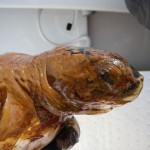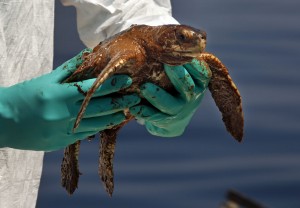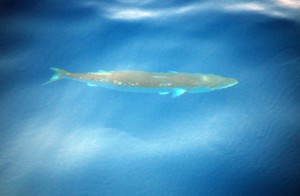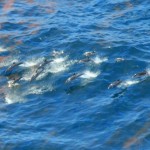Affected Gulf Resources
The trustees are evaluating potential oil spill impacts to sensitive habitats, fisheries, and wildlife, as well as current and completed restoration projects on the coast.
Download the April 2012 Natural Resource Damage Assessment Status Update for the Deepwater Horizon Oil Spill (pdf, 5 MB) to learn how NRDA teams are assessing damage in the Gulf of Mexico.
NOAA is concerned about ongoing and long-term impacts to:
Fisheries and Wildlife - During past oil spills in the Gulf of Mexico, NOAA has documented direct toxic impacts to commercially important aquatic life including blue crabs, squid, shrimp, and a variety fish species. Toxins in the oil can kill these species or have other harmful effects such as: genetic damage, liver disease, cancer, and reproductive, developmental, and immune system impairment in fish and other organisms.
 Fish and Invertebrates
Fish and Invertebrates
- Species with essential fish habitat near the oil spill include scalloped hammerhead, shortfin mako, silky, whale, bigeye thresher, longfin mako, and oceanic whitetip sharks; swordfish, white marlin, blue marlin, yellowfin tuna, bluefin tuna, longbill spearfish, and sailfish.
- Other important fish in the Gulf include red snapper, grouper, gray triggerfish, red drum, vermilion snapper, greater amberjack, black drum, cobia and dolphin (mahi-mahi), coastal migratory open water species, such as king and Spanish mackerel, and open water sharks.
- Shellfish in the Gulf include oysters and several species of shrimp and crabs.
 Turtles
Turtles
 At least four species of threatened/endangered sea turtles (Kemp’s ridley, green, leatherback, and loggerhead) are residents of the northern Gulf of Mexico and are represented by all life stages. A fifth species, the hawksbill turtle, can be found in the southern Gulf.
At least four species of threatened/endangered sea turtles (Kemp’s ridley, green, leatherback, and loggerhead) are residents of the northern Gulf of Mexico and are represented by all life stages. A fifth species, the hawksbill turtle, can be found in the southern Gulf.- The only nesting beaches in the world for Kemp’s ridley turtles are in the western Gulf of Mexico.
 Birds
Birds
 Marshes in the Gulf of Mexico provide extremely important habitat for feeding and nesting of several species that can be found in offshore waters, such Royal Terns and Gulls.
Marshes in the Gulf of Mexico provide extremely important habitat for feeding and nesting of several species that can be found in offshore waters, such Royal Terns and Gulls.- Species of concern include nearshore and marsh birds: brown pelican, diving ducks, wading birds, piping plover (a threatened species); and open water birds such as shearwaters, northern gannets, and frigates.
 Habitat
Habitat
 Current Gulf Restoration
Current Gulf Restoration
- Grand Isle/St. Bernard Shoreline Restoration Project: This project is building more than five acres of bioengineered oyster reef, which will protect 3.4 miles of vulnerable shorelines and 350 acres of emergent marsh along Grand Isle and St. Bernard Marsh, and more than 100 marine species associated with oyster reefs in the northern Gulf of Mexico will benefit. Local communities are also benefiting as skilled laborers have been hired to create the reef structures.
- The Coastal Alabama Restoration Project: A submerged breakwater reef is being created along two stretches of shoreline, protecting more than 18 acres of habitat for submerged aquatic vegetation and creating almost two acres of oyster reef. The submerged reefs will protect more than a mile of coastal habitat by reflecting erosive wave energy away from the shoreline, unlike traditional erosion protection structures that contribute to habitat loss.





